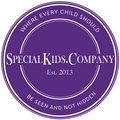
Writing tools to help children with cerebral palsy
What is cerebral palsy?
Cerebral Palsy is “the name for a group of lifelong conditions that affect movement and coordination. It's caused by a problem with the brain that develops before, during or soon after birth” (NHS).
If you have a child with cerebral palsy they may struggle with their fine motor skills and grasping small objects, such as a pen or pencil. It is also possible for them to experience pain and so-called hand fatigue when grasping objects that are not adapted to meet their needs.
In this blog SpecialKids Company will let you know about some of the adaptive writing tools available to help your child. It is worthwhile speaking to an Occupational Therapist to see if any of these handwriting tools can be provided through your local NHS board.
Writing tools for cerebral palsy
Pencil grips are often spongy in texture and provide a soft, comfortable non-slip grip when placed onto pencils and pens. There are a variety of types available on the market.
Unsurprisingly, weighted pens and pencils are heavier than standard ones. They can help to increase pencil and pen pressure without any added effort from your child. They are designed to help proprioceptive input in a child’s fingers and hands to help provide extra feedback.
Children with cerebral palsy are prone to postural issues and muscle tightening, which can make it difficult to maintain postural stability in order to write. An ergonomic slant writing board can be beneficial for some children. It sits at an angle and has a clamp for holding paper.
Writing claws are designed to help children hold a pencil or pen and correct the positioning of their fingers. There are three caps in which your child’s fingertips can sit into to help them grip a pencil or pen. Not only should the writing claw correct the positioning of your child’s fingers, it should help to prevent a painful grip.

Some children with cerebral palsy are unable to use pencils and pens at all due to their muscle function, grip and range of motion. In this instance, adaptive technology is the way to go. Some useful examples are:
- Larger key keyboards – some children find it difficult to press buttons on an average keyboard. The Big Keys LX keyboard has chunky keys, which are easier to press.
- Eye tracking devices and communication boards – children with cerebral palsy who have limited mobility often use eye gaze technology to communicate. Communication boards with eye tracking will allow a child to use visual cues such as images to communicate words and sentences.
AAC (augmentative and alternative communication) devices are available to help children to communicate and can also be used to help them to type. A great example is the Megabee Assisted Communication and Writing Tablet. Letters can be selected by looking and blinking.
We hope that you find these ideas helpful. What techniques have helped your child to write?

